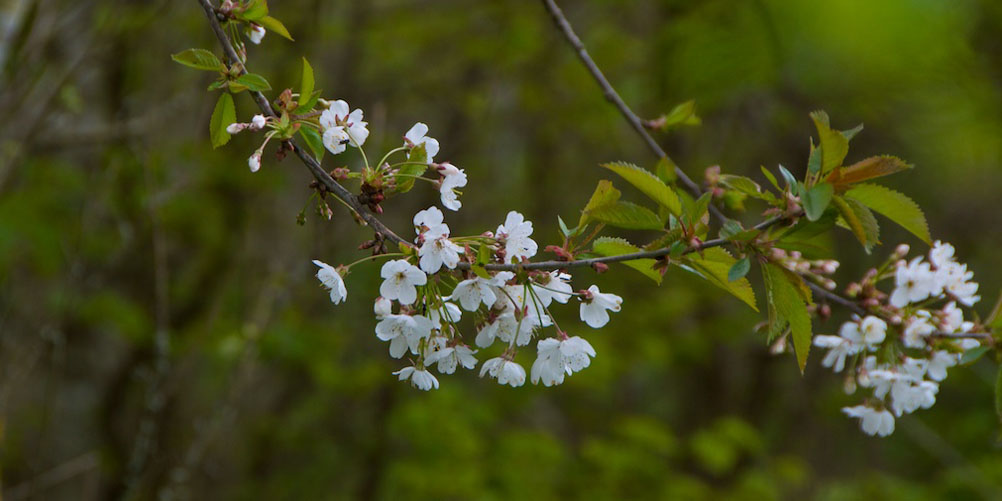
Wild cherry: the last snow of spring
Loveliest of trees, the cherry now
Is hung with bloom along the bough,
And stands about the woodland ride
Wearing white for Eastertide.
Now, of my threescore years and ten,
Twenty will not come again,
And take from seventy springs a score,
It only leaves me fifty more.
And since to look at things in bloom
Fifty springs are little room,
About the woodlands I will go
To see the cherry hung with snow.
A E Housman, ‘A Shropshire Lad’
The recent warm sunshine has brought out the wild cherry blossom, and its white garlands can be seen on hillsides, woodland fringes and roadside verges. The bitterly cold winds of early April seemed to hold everything tight in the bud, so this lovely display is especially welcome.
Two different types of cherry tree are abundant here in Scotland: the wild cherry (Prunus avium) and bird cherry (Prunus padus). In spring it is fairly easy to tell them apart: while the flower stems of wild cherry are each individually attached to the branch, often in a radiating cluster, the flowers of bird cherry are held in racemes almost like a lilac, upright at first and then drooping as the buds open. These two photos illustrate the difference:
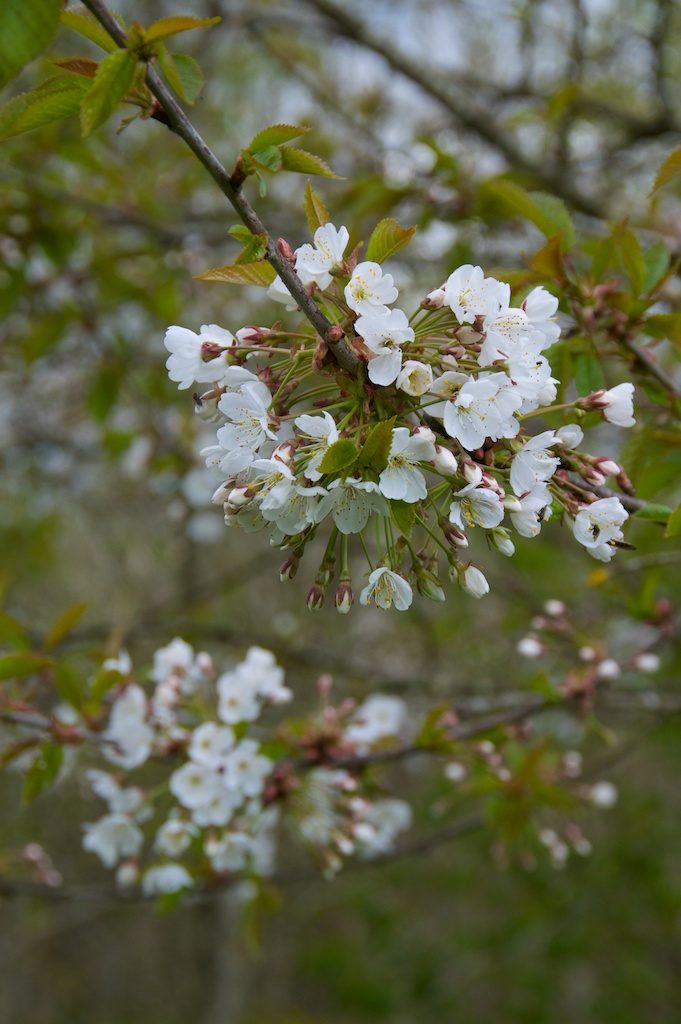
Wild cherry (Prunus avium)
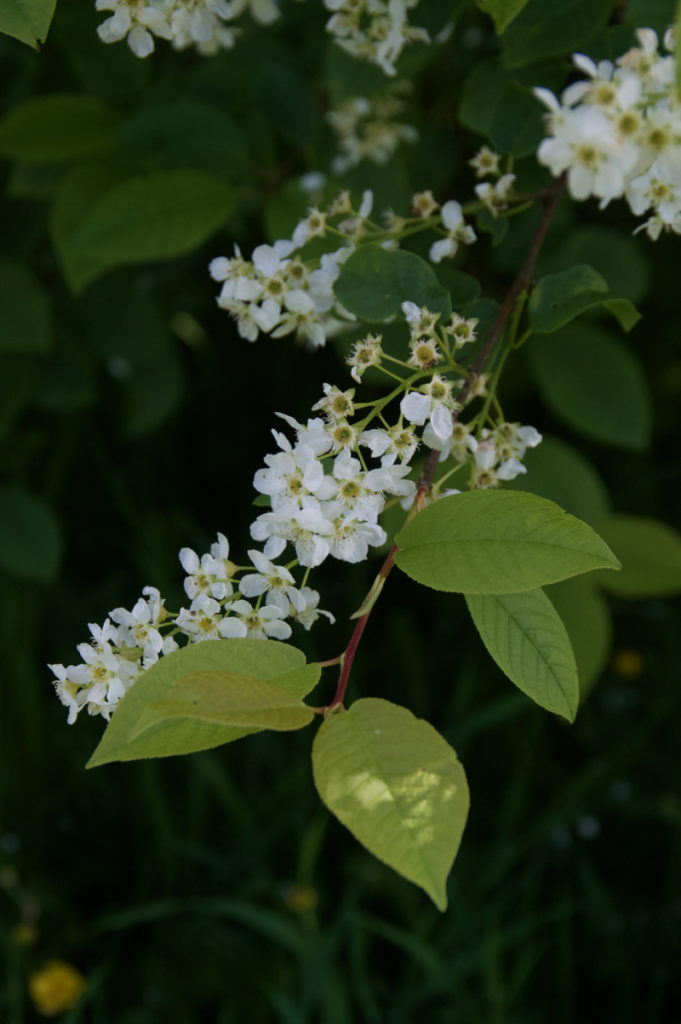
Bird cherry (Prunus padus)
Wild cherry, also known as gean or mazzard, occurs naturally throughout Britain and Ireland. It appears mostly as a slender tree of moderate height, but in maturity it can assume a wonderfully gnarled character with a thick crusting of bark on its twisting branches. It is said that many of the old cherry trees in Scotland grow on the sites of existing or abandoned villages.
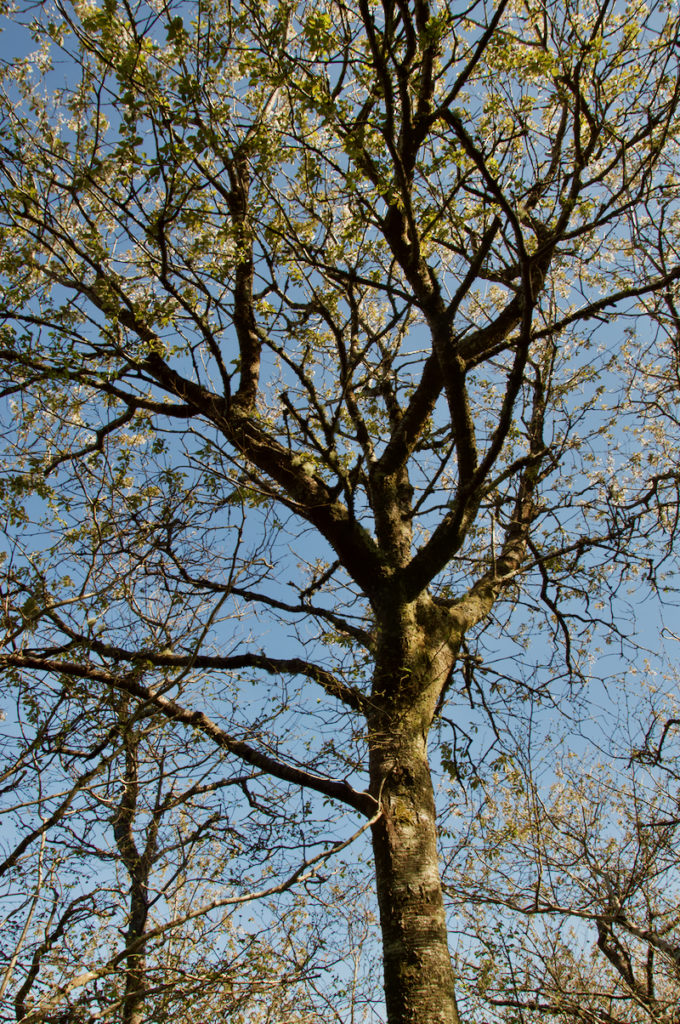 Wild cherry trees at Ballachuan, Seil Island
Wild cherry trees at Ballachuan, Seil Island
Five-petalled white flowers open to reveal a spray of orange-tipped stamens, inviting pollination by bees and other insects; as one of the early flowering trees, wild cherry is an important source of nectar. Tiny green fruits develop from the fertilised flowers, gradually ripening into dark red or black cherries which provide a valuable food for birds, mice and squirrels. As autumn advances, the leaves abandon their dull green in favour of vibrant amber and gold, often glowing with such fire that, from a distance, the tree appears to be lit from within.
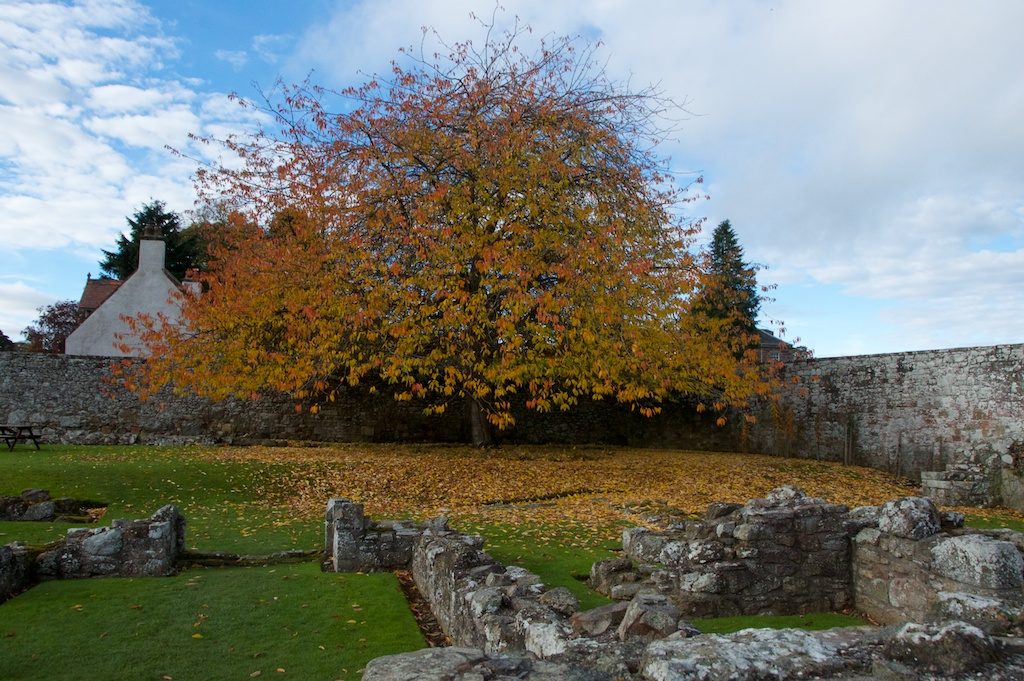 This cherry tree in the grounds of Melrose Abbey may be a cultivated variety, but I could not help including it because of its glorious colour.
This cherry tree in the grounds of Melrose Abbey may be a cultivated variety, but I could not help including it because of its glorious colour.
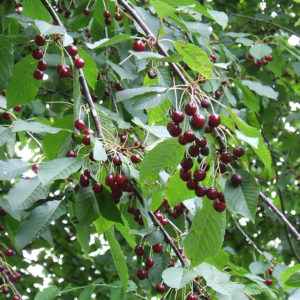
To our modern taste, the fruit of wild cherries may be bitter, but in ancient times they were widely enjoyed: cherry stones have been found in a Bronze Age crannog in County Offaly, Ireland, and they have also been exhumed from medieval latrines. One of the most popular uses, which still endures today, is in the making of cherry brandy: in its simplest version, sugar and brandy are added to a jar of cherries, and the brew is then sealed and left to ferment.
As a natural remedy, the powdered bark of the cherry tree was bottled in syrup or alcohol and consumed variously as a tonic, a sedative, or to relieve bronchitis. King Henry VIII, who believed that the fruit would relieve the inflammation of gout, planted a number of cherry orchards in Kent.
“…the gum of the cherry-tree dissolved in wine, is good for a cold, cough, and hoarseness of the throat; mendeth the colour in the face, sharpeneth the eye-sight, provoketh appetite and helpeth to break and expel the stone…” (Nicholas Culpeper, ‘The Complete Herbal’)
In Ireland the wild cherry was regarded as a symbol of love, youthfulness and beauty, and in parts of England, including the Chilterns, branches of blossom were picked to decorate churches at Easter. In some places, however, wild cherry was considered an unlucky flower to have at a wedding.
The eminent Scottish geologist Sir Archibald Geikie (1835-1924) brings us this insight into the origin of the wild cherry’s alternative name of ‘gean’:
“During school-life, another kind of education was going on in the country rambles to which Saturdays were devoted, and in which the boys in great measure taught each other. It was thus that we learnt to recognise trees and wild flowers. In our incursions into the woodlands we now and then came upon the little black wild cherries which we knew by the Scots name of geans. We afterwards learnt that this is the Scots spelling of guignes, the French name of the fruit, and one of the verbal relics of the ancient alliance between Scotland and France.” (Sir Archibald Geikie, ‘A Long Life’)
Wild cherry’s warm pinkish or honey-coloured wood was prized for cabinet-making and decorative joinery, and it was also a popular choice for musical instruments. The trunk of an old tree can produce large burrs which reveal beautiful patterns when polished. In his ‘Sylva’ of 1664, John Evelyn considered that cherry wood was “fit to make stools with, cabinets, tables, especially the redder sort, which will polish well; also pipes, and musical instruments, the very bark employed for bee-hives…”
An old country saying, which I had not heard before, states that the cuckoo will only stop singing once it has eaten its fill of cherries three times over.
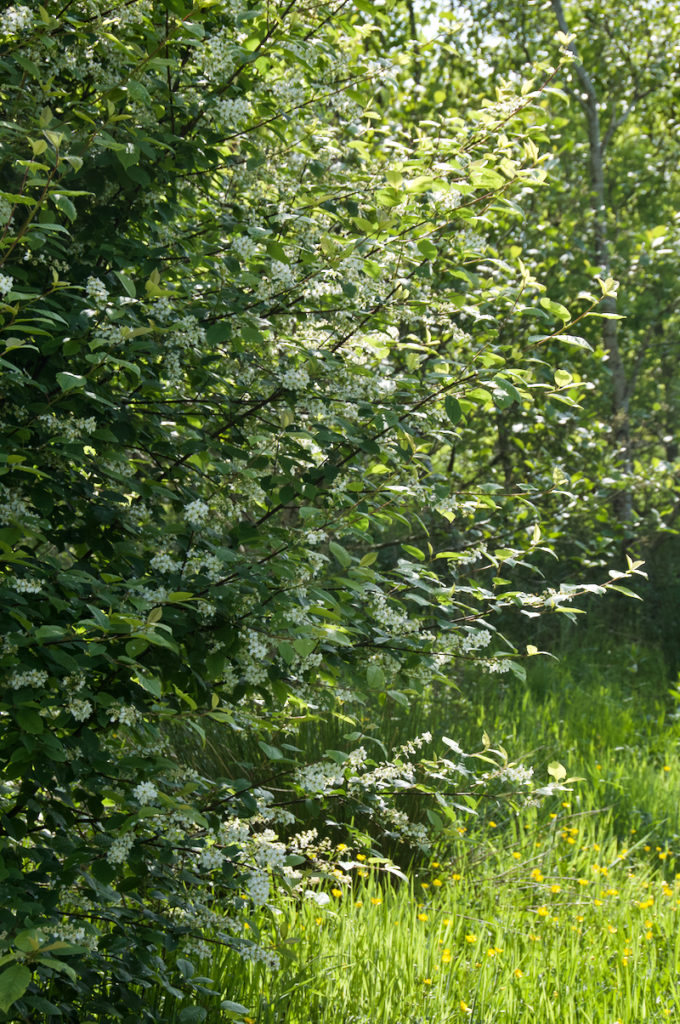
Bird cherry
Bird cherry is generally more common in the northern half of Britain and the far north-west of Ireland, and it also has strongholds in the East Anglian fens; it is absent from the Western Isles and from Orkney and Shetland. Its country names include ‘hagberry’ and ‘hackberry’, and in parts of north-east Scotland it is known as the witch’s tree: bird cherry wood was studiously avoided for carpentry or stick-making, and used only for firewood. The small black fruits or ‘hags’ are extremely bitter, and contain small quantities of hydrogen cyanide, which is considered to be fairly harmless to humans in low doses – although birds can apparently consume them with immunity. This bitterness did not deter folk from making sharp jams and jellies from the fruits; it is likely that any toxins may have been destroyed by boiling.
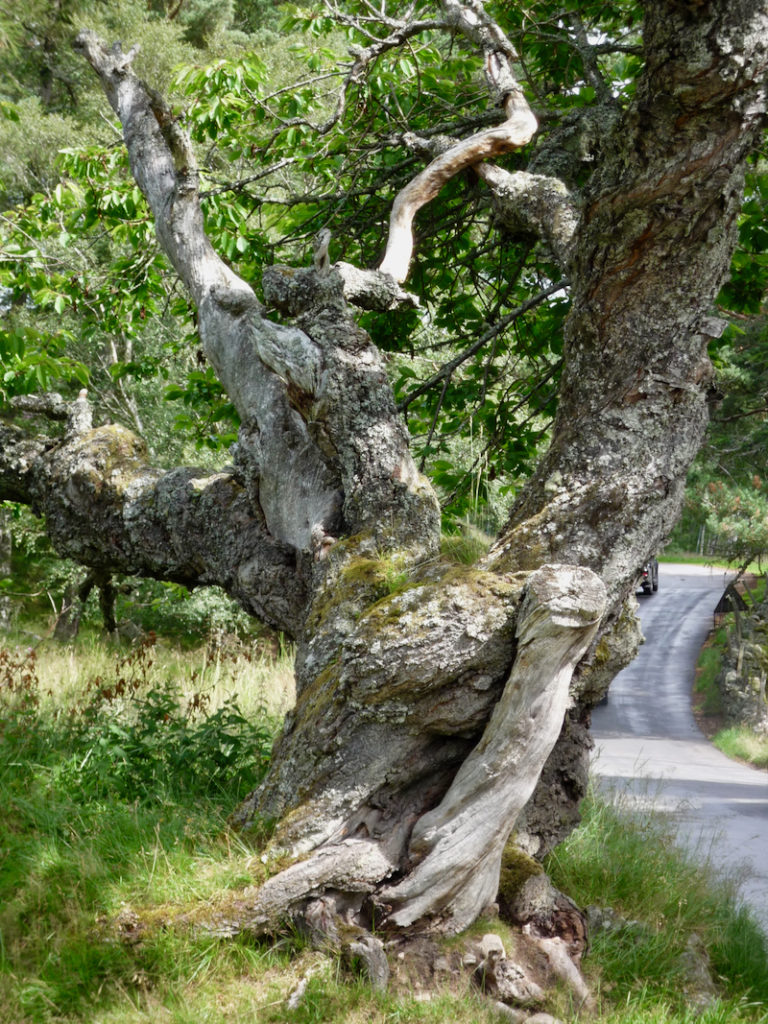 Wild cherry and bird cherry are regularly planted in new woodland, but very old specimens are uncommon. One of the oldest cherry trees I’ve seen was discovered beside a minor country road north of Balmoral in Aberdeenshire. Many of the modern cultivars, of course, are laden with blossom in various shades of pink, cream and white, and these make a breathtaking sight in our parks and gardens. But it can be just as rewarding to examine the fey beauty of a wild cherry, its delicate flowers trembling in a perfect natural posy, or shedding a snowstorm of petals into the warm spring breeze.
Wild cherry and bird cherry are regularly planted in new woodland, but very old specimens are uncommon. One of the oldest cherry trees I’ve seen was discovered beside a minor country road north of Balmoral in Aberdeenshire. Many of the modern cultivars, of course, are laden with blossom in various shades of pink, cream and white, and these make a breathtaking sight in our parks and gardens. But it can be just as rewarding to examine the fey beauty of a wild cherry, its delicate flowers trembling in a perfect natural posy, or shedding a snowstorm of petals into the warm spring breeze.
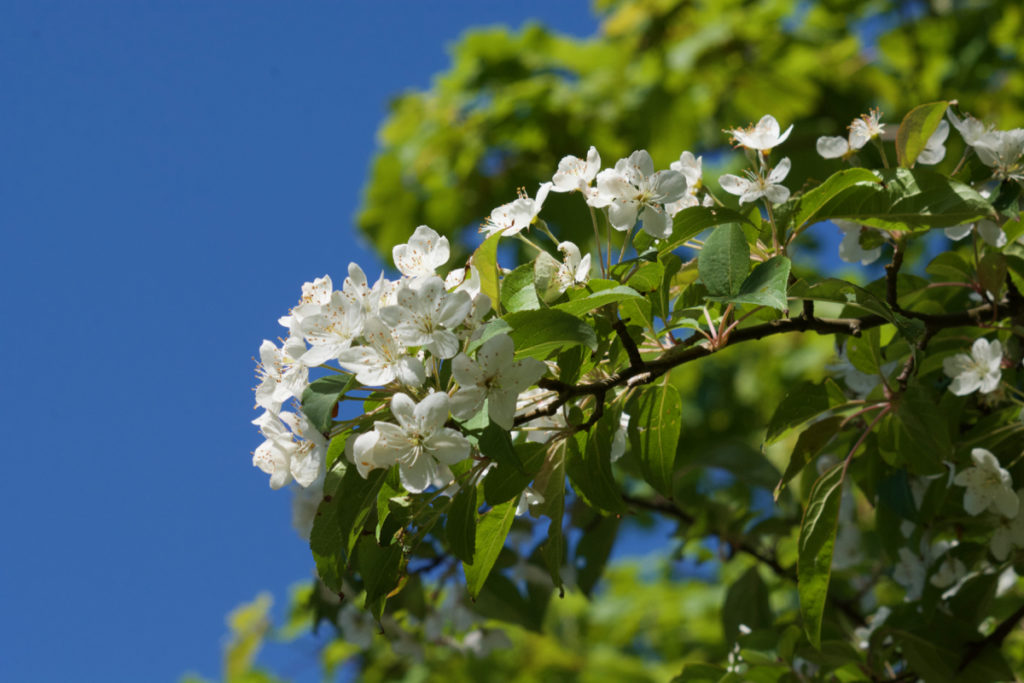
Update on my new book: I’ve now finished the text for ‘Britain’s Trees: A Treasury of Traditions, Superstitions, Remedies and Literature’, which will be published next year by The National Trust (Pavilion Books). If you enjoyed this post, I hope you’ll find much more of interest in this new book, which looks at all of our best-loved tree species and takes an enjoyable wander through some of our most colourful, curious, and time-honoured traditions.
Further reading and reference:
- ‘The New Sylva’ by Gabriel Hemery and Sarah Simblet (2014)
- ‘A Discourse of Forest-Trees’ by John Evelyn (1664)
- ‘The Complete Herbal’ by Nicholas Culpeper (1653)
- ‘Wayside and Woodland Trees’ by Edward Step (1904)
- ‘A Dictionary of Plant Lore’ by R Vickery (1995)
- ‘Flora Britannica’ by Richard Mabey (1996)
- ‘Trees of Britain and Ireland’ by Edward Milner (2011)
- Trees for Life: Bird Cherry
- Woodland Trust: Wild Cherry
- Woodland Trust: Bird Cherry
All images © Jo & Colin Woolf unless otherwise stated


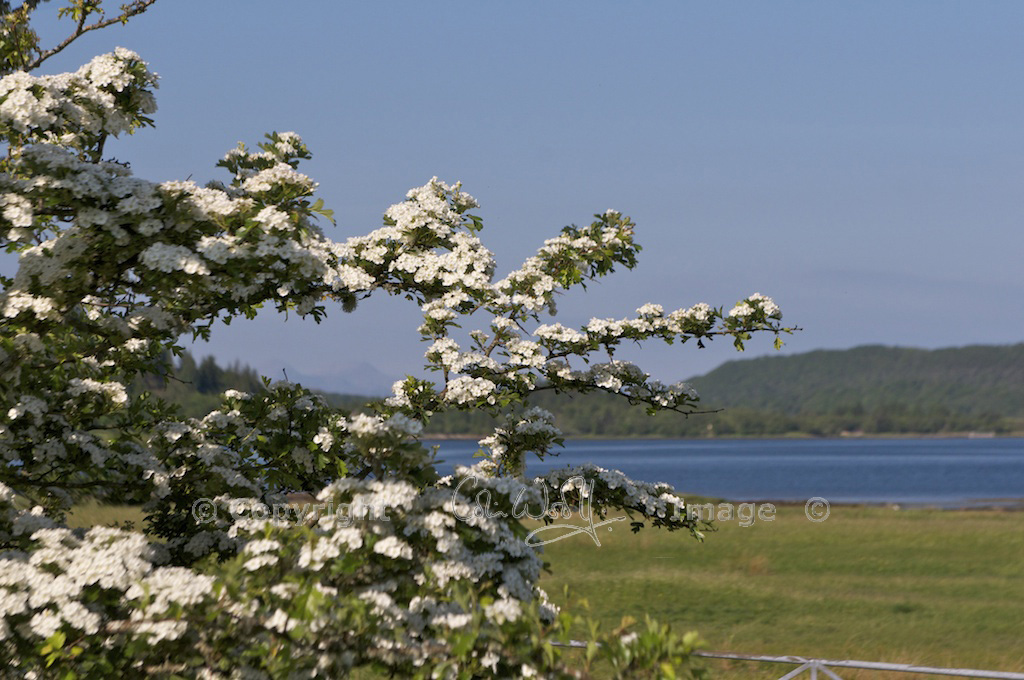
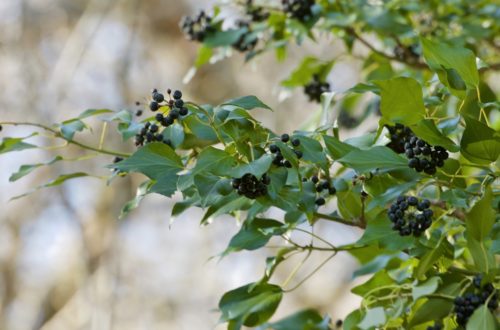
12 Comments
Norma Dowling
Thank you, Jo, I enjoyed your Cherry tree post.
I’ve missed your emails.
I was just walking round my garden on Mull. The Norway maple has dropped many of its petals on my drying green; pretty confetti and the leaf buds are opening. We have two Bird cherries, not yet woken up to spring. The beech trees are opening leaf buds too and the sycamores are a bit ahead of them! The goat willow ‘pussy’ buds are producing pollen.
I love this time of year! We couldn’t live without trees; Ted is whittling a sycamore spoon outside at the moment!
I am looking forward to your Book 🙂 I’d like to recommend one of my favourite old tree books: ‘The Tree Key’ by Herbert L Edlin. Published by Frederick Warne in 1978. illustrated by Ian Garrard. The perfect book to pop in bag or pocket when travelling!
Bestt wishes, Norma
Jo Woolf
Thank you for your lovely comment, Norma, and sorry that you’ve missed my emails! I’m looking forward to writing more posts from now on! Our sycamores are way ahead too, with the horse chestnuts not far behind, and the willows all coming out. I love how the oak trees look golden, with the new leaves and flowers. It’s such a beautiful time of year, as you say. A sycamore spoon! How lovely! Glad you’re looking forward to the book, and thank you for the recommendation – I’ll make a note and look out for it. All the best, Jo PS Mull is extremely hazy right now – a day or two ago we could see a last patch of snow on Ben More but I guess it’s gone by now.
Finola
Lovely post. Interestingly, cherries are still recommended for gout sufferers. Clinical trials indicated they may make a difference. Henry was on to something.
Jo Woolf
Thank you, Finola! 🙂 That’s good to know! I’m sure Henry would be pleased too!
Mary Smith
Lovely article. I was just admiring the wild cherry trees in blossom near Threave Castle this evening!
Jo Woolf
Thank you, Mary! How lovely – there’s so much blossom round here, too, and the blackthorn is quite late so it seems to have all come out at once.
montucky
Very interesting account of the wild cherries! I am very much looking forward to the cherry blossoms which will be seen here in several more weeks.
Jo Woolf
Thank you! Such a joy to see them, after a cold and windy spring. The last couple of days have been as warm as summer. I’m guessing you may still have snow but spring can’t be far away!
Sandra
Lovely post, Jo, and good to see you posting again. The new book sounds wonderful. I’ve immediately thought of a friend who would love it too!
Jo Woolf
Thank you very much, Sandra, and for thinking of your friend too! I really hope people will enjoy reading it as much as I’ve enjoyed writing it. It’s great to be back posting here again!
Scott K Marshall
Congratulations on your book, that completely passed me by – I know how hard you work and it is evident from your blog posts that your are blogging on a higher plane. I also love the new logo, recognisable and classy. Perhaps that is something I myself should revisit. Congratulations Scott
Jo Woolf
Thank you, Scott! I love what I do, and I was very lucky to be offered this opportunity. Thank you also for your kind comments! I love the new website although we’ve had our moments, haha!